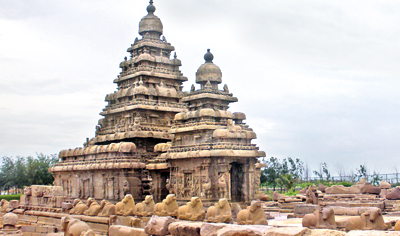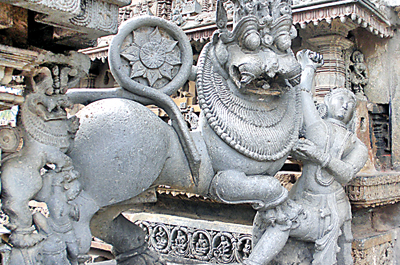South India in September
Sri Lanka has had a rich history of trade with south India. Lots of south Indian coins circulated in Lanka over many centuries. The mints that produced these coins were just names on my website on Lankan coins and I decided it was time to see some of these places and a few of the important museums and famous archaeological sites.
Flying into Chennai on Sunday, September 2, the airport was as messy as I remember it 30 years ago. The hotel which I had reserved by e-mail was clean and a request for a room on a higher floor, a bit away from a nearby kovil festival, with drums which went on most of that night was met.

Shore Temple at Mahabalipuram
The next morning we left by car to Mamallapuram (Mahabalipuram) 55 km south of Chennai. An ancient port which was the capital of the Pallavas from 600 to 750 CE, it is a large complex of temples with beautiful rock-cut art which one needs to walk around to a few separate locations to see. The Shore temple had been ravaged by erosion but the sculptures in protected caves were well preserved. It appeared that some of the art had been chiselled out from the rock and removed. The art is similar to that seen in Isurumuniya and Ran Masu Uyana in Anuradhapura which dates to the same era.
Next stop was Puduchcheri (Pondicherry) formerly a French enclave, now independently administered within Tamil Nadu State. After a very late lunch and some shopping at a craft exhibition, a room overlooking the nice beach front seemed a good option. The beach front was paved and closed to traffic from sunset to sunrise to allow it to be used for leisure and exercise.
Late that night, having got the SMS with the warning from the Government of Sri Lanka about travel in Tamil Nadu, I put away my Sri Lanka hat and t’shirt. The Times of India newspaper had a front page story about the deportation of the Sri Lankan football team. The nightly news on Indian TV and the Internet kept us informed of the incidents.
The next day it was off to Tharangambadi (Tranquebar) and the Danish Fort which was very interesting. But the Museum was small, and the few coins on display were disappointing for a place with a rich numismatic history. A small maritime museum had also been built after the tsunami.
Stopping next in Nagappattinam, we found the only attraction was the beach. When I asked about any place of historical interest, I was told that the Church at Vailankanni was a mid-16th century Basilica and just 12 km away. Totally unaware of the drama unfolding at that site, we visited around 2 p.m. without any sign of trouble. The main shrine was now a “Computerised Mass Offering Center” according to one large billboard. Metal tokens for INR10 were sold at another counter. I paid for one but when I gave the receipt at the next counter, was asked what I wanted. Seeing the blank look on my face, I was handed a token with a female figure. I later found out that each ailment had a different token. Had I known I would have got one of each for my collection.
As we were leaving, came the SMS with the news of the assault on the convoy of Lankan pilgrims on their way back to Trichy Airport. We had missed the incident at Vailankanni by a few hours. Anxious friends in Lanka kept calling.
Along the 80 km road to our next stop Thanjavur, we passed hundreds of pilgrims of all ages on a Pada Yathra (pilgrimage on foot). Each group had a small cart with religious statues they were taking to the Velankanni Festival.
The Tamil Nadu Tourism Hotel where we stayed was clean but poorly maintained. The very large Hindu shrine built by RajaRaja Chola in the 11th century, was open till late evening and we got in just before sunset and saw the enchanting temple as twilight faded. We decided to return at dawn to see the rest of it. The massive bronze Nata Raj was truly cosmic and the 17th century painting along the inner perimeter wall were interesting. No one knew of the 10th century painting of RajaRaja Chola and later we found out it was on the inner sanctum walls of the Temple which were not open to the public. Next we saw the Palace and Museum, which had a tower from which you got an aerial view of the region.

Sandula Lion at Belur: Similar to the lion at Yapahuwa
At Tiruchirapoalli (Trichy) the next day, the museum, though not easy to find, housed in a beautiful 17th century audience hall, had a small but well presented collection of coins and currency which even included some from Sri Lanka. We next visited the Rock Fort, which is on a 3.8 billion year old rock, which at 83m, is about half the height of Sigiriya. The climb to the Hindu shrines on top was from within the temple and the panoramic view of Tiruchi, was worth climbing the 344 steps barefoot.
The next day with few km to burn on the car rental, I decided to visit the grand anicut built by Karikal Cholan in the 2nd Century CE to harness the water of the Cauvery river with a bifurcation. Not being a popular tourist spot it was not easy to find. It was a pity that modern restorations left little of the ancient anicut visible. On the way back we visited Srirangam Temple Towers. Built between the 14th and 17th century, it is the largest temple complex in India.
The night A/C sleeper bus was a new experience. Starting at 10 p.m. we reached Bangaluru (Bangalore) just after 5:30 a.m. On an afternoon city tour of Bangalore, we saw the Science and Technology Museum, which was the last stop on the Bangalore tour.
A Tour Bus ride to Mysore left little time to see the Palace and Museum properly. The last stop was Brindavan Gardens, but the rain was a spoiler. We went across by boat to the south side, but it was no fun to see it walking in the rain. We returned to Mysore for the night.
The next day our destination was the Halebidu and Balur, the 12th century kingdom of the Hosyala. The 325 km round trip from Mysore, to see these exquisite carved rock temples is a must for anyone visiting the area. Sandula the lion which looks just like the lion at Yapahuwa is of iconographic interest.
That night being Sunday we saw the Mysore Palace lit up- a glorious sight before taking the night sleeper train from Mysore back to Chennai, to the same hotel we had been in. The Chennai Government Museum, one of our last stops, reminded me of the Colombo Museum, before recent renovations, with the same gloomy atmosphere. Only the Bronze gallery had been renovated and properly illuminated, and two other galleries were closed for renovation. The temporary coin and medal gallery was a disappointment. That evening we visited a leading numismatist in Chennai and saw his fabulous collection of Chola coins which I hope he will display online someday.
The St George Fort Museum which we visited the next day had a nice numismatic collection, very well displayed. On the way to the airport at midnight, there were fresh reminders of the current tensions- huge posters in Tamil, pasted on walls with a large picture of Prabhakaran and the date 2012-09-13. We were glad we were leaving before whatever that day’s rally was. Still it was a great 10-day visit to south India, despite the anxiety of the travel warnings.
For more of the writer’s travel see http://lakdiva.org/suntimes/south_india_travel_2012.html
Follow @timesonlinelk
comments powered by Disqus
















